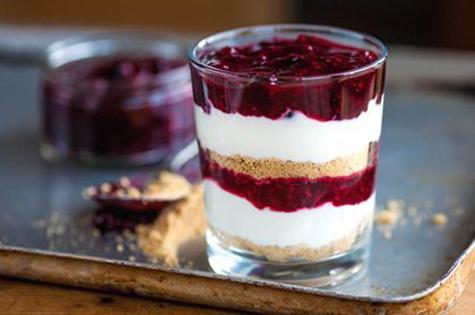We’re sure you’ve noticed like we have, but the berries have been extra yummy this season … and inexpensive too! It's not so good for our farmers, but it is for households. The cheapest we’ve seen so far is four strawberries of punnets for $5 - and they were delicious. Have you seen anything that beats that?
But even as the fresh berries get towards the end of their top taste, you can always use frozen mixed or individual berries for this recipe which is sure to be a favourite with kids and adults.
This is also a great recipe to get the kids involved in preparing with you. They can help crush the biscuits or create the layers, and because it's served in a glass, it looks fabulous.
Ingredients
- 370g of frozen mixed berries or individual fresh berries
- 1 tablespoon of brown sugar
- 10 plain, semi-sweet biscuits suitable for crushing (brand names might include Milk Arrowroot, McVitties Digestive, Shredded Wheat)
- 370g of light Greek yoghurt
Method
1. Place the berries in a small saucepan over a low heat with the brown sugar. Cook the fruit until soft, then remove from the heat and allow to cool.
2. While the berries cool, crush the biscuits in a mixing bowl with the back of a spoon. (If your child wants to help in the kitchen, this is a fun step. They can smash the biscuits until they’re shattered into crumbs.
3. Place a layer of crushed biscuits into the bottom of each serving glass.
4. Now create the layers by spooning-in 1cm of the Greek yoghurt, followed by 1cm of the cooked berries. Repeat this until you have two layers of each flavour (six layers in total). (This is another good activity for kids).
4. Serve immediately, or refrigerate for later.
By the way
If you’re wondering what the difference is between Greek yoghurt and natural yoghurt, here’s a summary from dietitian Kari Hartel.
- Greek yoghurt is almost double the protein
- Greek yoghurt has fewer carbohydrates
- Regular yoghurt has about three times the calcium, but both are still considered good sources of calcium
- Greek yoghurt has half the salt of regular
- The calorie or kilojoule count is similar
- Greek yoghurt is thicker and creamier which is why it is good for cooking as it doesn’t curdle
- From an overall health perspective, both types of yoghurt are good substitutes – for example instead of cream, mayonnaise, in dips, sauces or smoothies. The key is to choose low-fat or non-fat varieties with little to no added sugar.



















__small.png)










